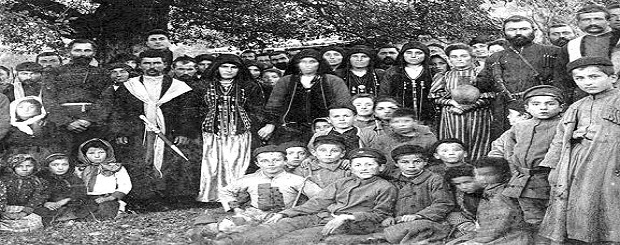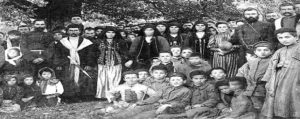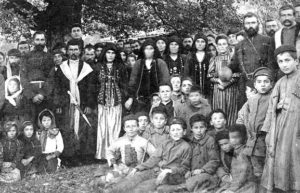
“Vainakhs-Christians”: when the Ingush and Chechens were Orthodox – when the Ingush and Chechens were Orthodox
June 7, 2019 – HISTORICAL PAGES. – //rambler.ru//

The Caucasus became one of the first regions of the Earth to be preached by the teachings of Christ. Here, earlier than anywhere else, Christianity was established as the state religion. In 314 (or 301), under King Tiridate III, Armenia becomes Christian, in the 337th – Iveria (Eastern Georgia) under King Mirian III. After 371, Urnair, king of Caucasian Albania, was baptized.
The power of the Iberian and Albanian kings extended to the slopes of the Greater Caucasus, where the ancient Vainakhs (ancestors of Chechens and Ingushs) lived. The preaching of Christianity took place there.
Christianity in the East Caucasus
The Church of Caucasian Albania played a large role in the spread of Christ’s teachings in the East Caucasus. Church tradition links the first sermon of Christianity here with the name of the apostle of the twelve Bartholomew. According to legend, the Apostle Bartholomew was martyred (he was skinned alive) in the city of Albany, by which most researchers understand a certain place in Caucasian Albania. Until 1937, an Orthodox church stood in Baku on the site of an ancient basilica, where, according to legend, St. Bartholomew.
Elisha, a disciple of the seventy Thaddeus, also preached in Albania. Elisha is a locally revered saint in the Udi churches of the Armenian Gregorian Church. Oudins – the people of Dagestan, who are a direct descendant of the Caucasian Albanians and who have preserved the Christian faith from those ancient times.
By tradition, the first Catholicos of Armenians Equal-to-the-Apostles Gregory the Illuminator is considered to be the baptizer of Caucasian Albania. He converted to Christianity the king of the Albans, Urnayr. Historians consider this tradition anachronistic – Urnair ruled in the second half of the 4th century and was still a pagan in 371, and Gregory the Illuminator died in 326. He was not baptized by the grandson of Equal-to-the-Apostles Gregory – St. Grigoris Albansky, who took initiation from his grandfather.
Grigoris became the first bishop of the Albanian church, but he was martyred before the reign of Urnayr. However, his sermon took deep roots, and at the end of the 4th century a powerful Christian community existed in Caucasian Albania, which ultimately contributed to the baptism of the country’s rulers.
The Albanian church was a subsidiary of the Armenian, but soon became autocephalous. In 451, both of them rejected the decisions of the Fourth Ecumenical (Chalcedonian) Council, which condemned Monophysitism (the doctrine of the one – Divine – nature of Christ).
The power of Albania and the jurisdiction of its church extended to a significant part of the Mountain and Seaside Dagestan. From the middle of the 7th century, Caucasian Albania began to be subjected to frequent attacks by Arabs and Islamization. In the IX century, this state disappears from the pages of chronicles. Many Christians fled persecution into the mountains of the North Caucasus.
Strengthening Christianity in Chechnya and Ingushetia
Historians usually call the beginning of the preaching of Christianity among the Vainakhs of the 8th century and indicate that it came from the Abkhazian and Georgian kingdoms, which were in close alliance with the Byzantine Empire.
However, as we showed above, the ancestors of the Chechens and Ingush could get to know Christianity much earlier – from Caucasian Albania. Under the influence of a new wave of preaching among the Vainakhs, the Orthodox version of Christianity established itself instead of the original – Monophysite.

Recently, scientists have established that the oldest surviving Christianity monument in Ingushetia – the temple of Albi-Erdy – was built in the 7th century, that is, three centuries earlier than previously thought. If so, then the time of its construction coincides with the time of the beginning of the ruin of Caucasian Albania by the Arabs.
In an era when Transcaucasia fell to some extent under the rule of Muslims, and the North Caucasus became an arena of struggle between Arabs and Khazars, the deaf gorges of the Caucasus Mountains became refuge for many Christians from the plains. When the power of the Arab caliphate began to weaken, and he began to lose territory in the Caucasus, the Christian states of the region strengthened again. A great role under King David IV the Builder (1089-1125) began to play the Georgian kingdom. By the way, David the Builder recaptured Tbilisi from the Muslims and transferred the capital of Georgia there.
Georgia is consistently strengthening its position in the North Caucasus. Queen Tamara (1166-1213) strengthens the position of the church there. In 1318, the Georgian Catholicos Patriarch Euthymius III visited parishes in the lands of Vainakhs and Avars – the first known trip of the Georgian First Hierarch to Chechnya, Ingushetia and Mountain Dagestan. The population of these countries at that time was overwhelmingly formally Orthodox, although it retained many vestiges of paganism that the clergy tried to plague.
The reign of Christianity at that time in the Vainakh lands is evidenced by the remains of numerous ancient Christian churches in Ingushetia. In addition to the above, these are Thaba-Erdy (best preserved), Targim, Dolte and others. As a rule, Vainakhs built Christian temples on the site of former pagan shrines.
The rise and fall of Christianity in Chechnya and Ingushetia
Since the VIII century, precisely, and possibly earlier, most Vainakhs professed the faith of Christ. In the XIV century, Catholicism began to struggle with the Orthodox Church, whose influence was made possible thanks to the Golden Horde, to which the plains of the North Caucasus were subordinate.
The Black Sea coast was dotted with colonies of Genoese merchants, and the preaching of Catholic missionaries from there reached the heights of the Caucasus. Probably, the dispute between Orthodoxy and Catholicism shook the confidence of the Vainakhs in the correctness of Christianity.
The decline of Christianity was associated with the adoption of Islam by the Golden Horde, the campaigns of the Central Asian conqueror Timur and the spread of power of the Ottoman Empire in Transcaucasia. Most Vainakhs return to paganism.
The 17th century is characterized by a partial revival of Christianity in the region in connection with the short-term strengthening of Georgia. But Islam is gaining ever stronger positions among the Vainakhs.
Nevertheless, Christian communities and many churches continued to operate until the middle of the XIX century, almost until the transition of the region to Russian rule. The service was conducted according to books written in the ancient Georgian language.
The lack of finds of Armenian church writing and graffiti among the Vainakhs does not allow many researchers to say so far that Christianity was brought here from Caucasian Albania earlier than the VIII century.
The complete eradication of Christianity (as well as paganism) among the Vainakhs was undertaken by Imam Shamil in the middle of the XIX century in order to achieve the moral and political unity of his state in the war with Russia.

weekend.rambler.ru/read/42304379-vaynahi-hristiane-kogda-ingushi-i-chechentsy-byli-pravoslavnymi/?
ENGLISH TRANSLATION “lousavor avedis”
